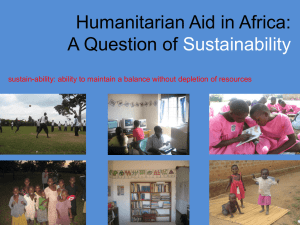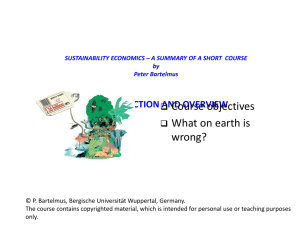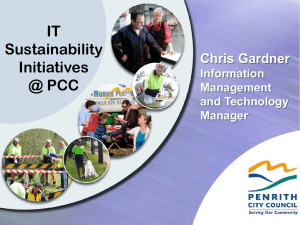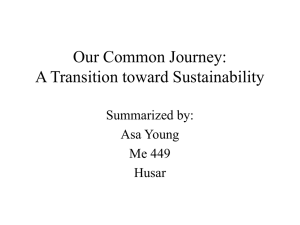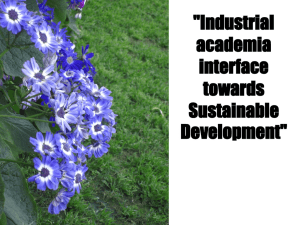Sustainability evaluation of community managed
advertisement
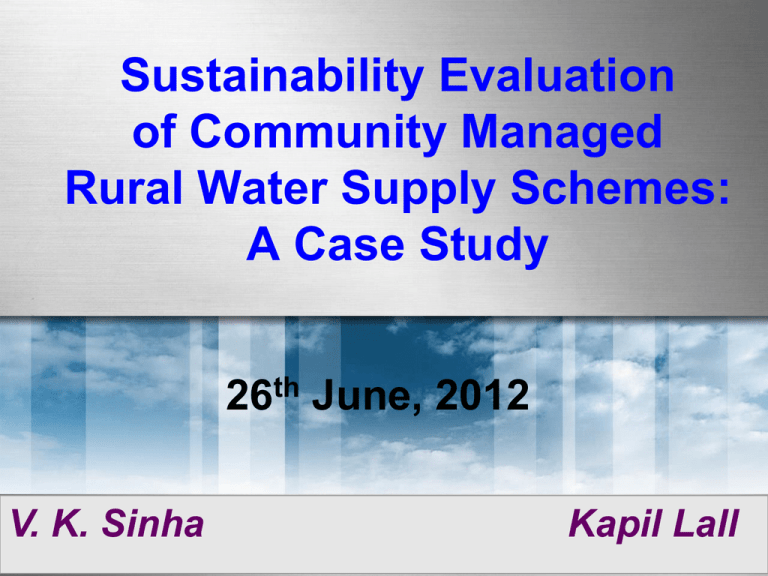
Sustainability Evaluation of Community Managed Rural Water Supply Schemes: A Case Study 26th June, 2012 V. K. Sinha Kapil Lall Presentation Structure Background Conceptual framework of sustainability Sample for the study Findings from the field Likelihood of sustainability Conclusion Here comes your footer Page 2 2 Background Massive investments in RWSS, yet level of service is far from satisfactory. Since long sustainable delivery of RWSS has been a cause of concern for those of us who are involved in trying to improve RWSS service whether as donor/govt./NGO/Program Manager etc. Sustainability is a key criteria for financing by external agencies. Like human health, health of projects/programs needs to be periodically assessed by conducting comparative study on field data and envisaged outcomes preferably by an external agency. Here comes your footer Page 3 3 Background URWSSP is Uttarakhand. under implementation in the State of The Indian Institute of Public Administration (IIPA) was engaged by the State Government in 2011 for carrying out sustainability evaluation study in order to monitor the project from a sustainability perspective to get an idea about the adequacy of the project design & the quality of implementation of the project processes. Built around sustainability issues and concerns of URWSSP. It takes a hard look at our limited achievements, point outs areas where our approaches need to be improved and sets some challenges. Here comes your footer Page 4 4 URWSSP in Brief Integrated Delivery of Water Supply, Sanitation & CACMP To improve the effectiveness of RWSS services through decentralization and increased role of PRIs & involvement of local communities in the Sector Wide Approach (SWAp). Project Period Project Cost 2006-2014 US $: 224 Mn Implementing Agencies UJN, UJS, PMU Target Habitation Target 8270 Project Area ODF 470 GPs Target Entire Rural Area CACMP 25% of NC/PC Here comes your footer Page 5 5 Conceptual framework of sustainability: A Service is Sustainable when It can be operated & Maintained at local level It requires feasible external support only. It functions and is being used; Sustainable Service Its management is institutionalized It is able to deliver an appropriate level of benefits; It remains operational beyond the life cycle of the initially installed equipment; It does not negatively affect the environment; It has all its O&M costs recovered; Here comes your footer Page 6 6 THE SAMPLE FRAME AND SIZE Technology Used 26% 14 Gravity 50 Pumping 3 10 3 90 97 100% 21 40% 80% 60% 18 40% 34% 20% 0% Garhwal Gravity Kum aon Pum ping These schemes had operated for 6 months or more than 6 months and were in the O&M Phase. 27 16 10 A total of 1529 users were covered during the study. Here comes your footer Page 7 7 Findings on Physical Condition The sustainability of the sampled schemes was assessed by looking in to its physical, institutional and financial as well as the social condition that ensure its sustainability. (21 Indicators) A large majority of sampled SWAp schemes are functioning satisfactorily, and providing improved as well as regular water supplies to users. Functional Status of Schemes 120 100 97 95 96 % 80 60 40 20 5 3 4 0 Garhwal Kumaon Functional Total Non Functional Here comes your footer Page 8 8 Findings on Physical Condition The quality of civil works related to each of these schemes covered was exceptionally good and rigorous procurement and quality control procedures seem to have been followed at the time of the construction The sufficiency of yield from the source and its regular and timely measurement has very important implications for sustainability. Therefore, much more focus on CACMP works should be taken up. Regular water testing at the grass roots level (UWSSCs and Users) needs to be vigorously propogated. , Here comes your footer Page 9 9 Findings on Physical Condition Marked improvement has been reported in the use of household toilets, hygiene practices among users, and overall environmental conditions in the covered habitations. The level of training on financial management and book-keeping , catchment area protection, as well as the preventive maintenance has been found to be satisfactory however, the training in these project components needs to be strengthened further to better assist UWSSCs for carrying out various O&M functions. Here comes your footer Page 10 10 Findings on Institutional Condition Functional Status of UWSSC The UWSSCs have been duly formed as stipulated in all sampled schemes, and are functional in all except two cases. The composition of UWSSC members reveals sensitivity towards ‘inclusiveness’ and gender concerns. Though the bye-laws of UWSSCs have been formulated and duly approved as stipulated, there is much to be desired in the effective functioning of Social Audit Committees. 97 95 96 100 80 % The cohesion, and community participation has been remarkable in most cases. There is a satisfactory level of community involvement in O&M functions, and this has been a major achievement in most schemes. Adequate care of assets takes place in most schemes. However, this element requires greater attention as assets created get older and worn out. Here comes your footer 60 40 5 20 4 3 0 Garhwal Kumaon Total Functional Non Functional Page 111 1 Findings on Financial Condition Users charges have been fixed in accordance to guidelines, and in many cases revised upwards. The effectiveness of the tariff system and its enforcement is satisfactory. Incentives for timely payments or penalties for late payment should be introduced. The average revenue exceeds average expenditure in most schemes, and thus the financial health of most schemes is satisfactory. The status of payments by over 77 percent of sampled users is good and regular. It may be said that the current status of tariff payments is good, and the default rate manageable at the moment. Greater attention needs to be paid regarding the book keeping and records. If need be refresher training should be organized for UWSSCs members. Here comes your footer Page 12 12 Findings on Social Condition The schemes have achieved a creditable degree of inclusiveness of the weaker and vulnerable sections through providing them with the required water supply. The schemes have had a remarkable impact in significantly improving water availability in the covered habitations. The appreciation and approval for the scheme among users is very high invoking greater participation, and involvement among users. The vast majority of users have a very high sense of satisfaction, and appreciation regarding the management of the schemes. They are also very positive in their responses regarding the quantity and quality of water being provided to them. Here comes your footer Page 13 13 Findings on Social Condition The schemes have effectively reduced the drudgery of water collection; More than 60% of the users have reported that they save up to 3 hrs. or more each day for water collection Time Saving Due to Convenient Availability of Water Value in % 50 40 30 20 32 45 38 24 10 44 17 0 Upto 1 hrs. Upto 3 hrs. Garhw al Here comes your footer Kumaon More than 3 hrs. Page 1414 Findings on Social Condition The overall user satisfaction related to the functioning of SWAp schemes is very high, and thus positively reinforces, as well as strengthens participation along with compliance. The resulting social condition is thus enabling, and contributes significantly to ensuring sustainability. Reduction in Water Borne Diseases 100 90 87 80 70 60 % The schemes have also had a significant impact on the perceptions of users with regard to improved health and sanitation. 50 40 30 20 10 7 6 No Don,t Know 0 Yes Here comes your footer Page 15 15 Initiatives for improvement District level workshops of all stakeholders will be organized to give feedback to the GPs and UWSSCs on problems, issues & interventions planned at the village level; Cross visits to sustainable villages will also be arranged. Refresher training of UWSSC members will be provided especially in financial management and book keeping ; Prizes and awards will be instituted for UWSSCs who address their issues and problems before subsequent sustainability monitoring exercise. Micro-level interventions at the village level and Macro-level policy adjustments at District and State levels will be initiated on the basis of feedback; Here comes your footer Page 1616 Likelihood of sustainability • Bullet 1 Remote & inaccessible location of most habitations. Felt need • Bullet 2 • Bullet 3 Demand for an improved service by the community. Manifestation of the demand by initial community contribution & commitment for O&M. Appropriate Informed Choice Technology Participation Participation Information on system options, as well as cost and technical implications of each system were made available to the community. Technology options selected with the communities and adapted to the community’s capacities and needs. Involvement of community’s from the very start of the project cycle. Users in the driving seat. Use of local language. Here comes your footer Page 1717 Likelihood of sustainability LOW O&M COST Appropriate TARIFF Technology • Bullet 1 Gravity based water supply schemes. • Bullet 2 • Bullet 3 Personnel costs low as GPs have appointed local residents as caretakers. Timely revision of tariff by GP/UWSS to keep pace with increasing O & M expenses ; Cessation of Political Pricing; Willingness to pay. Technical Skills at local level. Participation O&M Easy availability of spare parts. Regular preventive maintenance. Here comes your footer Page 1818 Likelihood of sustainability Revenue VS Expense • Bullet 1 revenue exceeds average expenditure in most schemes. Average • Bullet 2 Financial • Bullet 3 health of most schemes satisfactory. Current status of tariff payments is good. Default rate manageable. Legitimate and organized community structure Appropriate Management Technology Capacity Post Participation implementation support Legal status to UWSSC Established management capacity of GPs/UWSSCs to sustain adequate services. UJS as back stopping agency for providing technical assistance in case of major breakdowns and natural calamities during post implementation period to PRIs. Periodic refresher training for village level functionaries. Here comes your footer Page 1919 Conclusion Sustainability starts at the planning phase. Careful planning of O&M systems must already be completed during the planning and design phase because effective O & M is essential for sustainability. An overall picture is emerging that communities are capable of managing their water supply systems but they need backup support. Perhaps 3 – 4 years period is too short to prove sustainability conclusively. Evaluation is learning: No solution is forever. “If anything can go wrong, it will” Here comes your footer Murphy’s Law Page 2020 Thank you for your attention Contact Information: Kapil Lall e. mail: pmu_uttaranchal@rediffmail.com V K Sinha e. mail: swsm.uttarakhand@gmail.com Here comes your footer Page 2121

